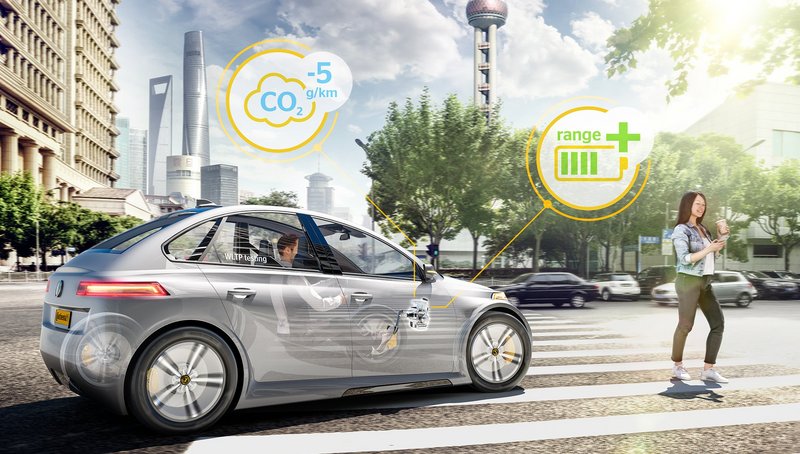Continental MK C1 Brake System Reduces CO2 Emissions of Hybrid Vehicles
- Regenerative energy savings due to improved utilization of achievable recuperation potential
- Tests of the CO2 savings potential of the MK C1 electrohydraulic brake system in a plug-in hybrid
- TÜV confirms in a certified test: MK C1 reduces the amount of CO2 emitted in the WLTP by around 8 g/mi on average compared with a conventional hydraulic hybrid brake system
Auburn Hills, Mich., April 16, 2019. Against the backdrop of stricter CO2 legislation around the world, a major focus for automakers is reducing emissions gram by gram. In the U.S., a maximum of 213 grams of greenhouse gas (GHG) – which is primarily composed of carbon dioxide (CO2) – per mile is currently stipulated by 2020. Besides the powertrain, other vehicle systems are required to play their part in emissions reduction, such as the brake system.
“Based on a recent TÜV-certified test, the MK C1 electrohydraulic brake-by-wire brake system, installed in a standard plug-in hybrid vehicle, reduced CO2 emissions by around 8 g/mi on average compared with a conventional – non-brake-by-wire – hybrid brake system,” said Robert Beaver, chief engineer of Electronic Brake Systems at Continental North America.
WLTP confirms CO2 reduction
The measurements were taken on a dynamometer test in accordance with the Worldwide harmonized Light vehicle Test Procedure (WLTP), the globally valid measurement procedure for determining exhaust emissions and fuel/electricity consumption of motor vehicles, and were supervised by TÜV experts present. During each of the three test runs, the vehicle with the MK C1 recovered 160 Wh of additional electrical energy on average in the deceleration phases of the individual cycle – around 32 percent more than the system in comparison. The MK C1 makes this possible by enabling consistent use of the electric motor as a generator during braking. The intelligent hybrid control can then use the additional electricity generated in this way for fuel-efficient driving, reducing CO2 emissions and fuel consumption.
“For the efficiency of a hybrid vehicle, it is important to use up as little of the vehicle’s kinetic energy as possible on the wheel brakes, because this energy is lost. Our MK C1 brake-by-wire system enables full utilization of the recuperation potential. This allows the vehicle to recover more electricity and achieve measurable CO2 savings,” said Beaver. The MK C1 has been manufactured in series production for the U.S. market in Morganton, North Carolina, and was recognized in 2017 with the prestigious Automotive News PACE Award.
Recuperation without compromise
In a hybrid vehicle, the seamless transition (brake blending) from regenerative braking (recuperation) to mechanical friction brakes is subject to limitations. The problem with a conventional hybrid brake system, complete with tandem main cylinder, brake booster and control system as separate main components, lies in the lack of pedal decoupling. This is also the case in the plug-in hybrid tested. By contrast, the brake pedal in the MK C1 is usually completely decoupled from pressure generation, always giving the driver a uniform pedal feel. Full use can be made of recuperation phases – saving CO2 as a result.
Efficiency and dynamism in a single module
Calculated for an electric vehicle with an energy consumption of 29 kWh/100 miles, the increase in the efficiency of the MK C1 documented in the test alone would equate to a 4 percent increase in range based on a 310-mile route – in other words, more than 12 miles. At the same time, the MK C1 has safety advantages: The electromechanically generated full brake pressure reached within 150 ms, allowing advanced driver assistance systems or automated vehicles to be brought to a standstill more quickly from a higher speed without driver intervention than in the case of conventional brake systems.
“This provides a longer time frame in which an automatic emergency braking function can detect an obstacle with absolute certainty and initiate autonomous emergency braking successfully,” said Beaver. “Efficiency and safety go hand in hand with the MK C1. This electrohydraulic brake system is therefore perfectly suited for the global trends of electrification and automation.”
Continental develops pioneering technologies and services for sustainable and connected mobility of people and their goods. Founded in 1871, the technology company offers safe, efficient, intelligent, and affordable solutions for vehicles, machines, traffic and transportation. In 2018, Continental generated preliminary sales of €44.4 billion and currently employs around 244,000 people in 60 countries and markets.

Kathryn Blackwell
Vice President, Marketing & Communications

